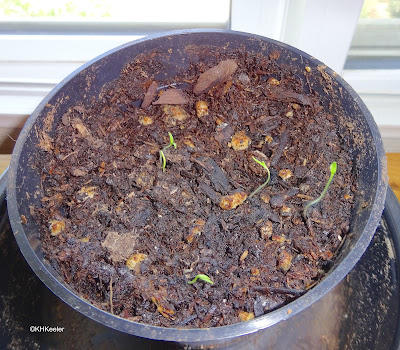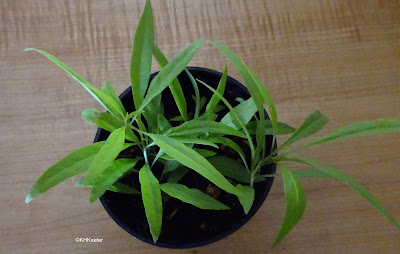The familiar fruits of the U.S. are only a small portion of the fruits eaten around the world. One that appears increasingly in the U.S. is the goji berry. As with many new fruits, they have lots of names, few in widespread use. They're called Chinese wolfberries, Chinese box thorn, Barbary box thorn, and matrimony vine. Two species are sold commercially, Lycium chinense and L. barbarum. The Chinese name is gojizi or, in some transliterations, kouchi, which often becomes goji berry. There are other Chinese names for the fruit, such as yang-ju, and specialized Chinese names for leaves and stalks, which are used in traditional Chinese medicine.
 |
| goji berries, Lycium species, for sale in China |
As dried fruit, goji berries are sweet but not very sweet. One of my books says they taste like licorice. I can detect what he thought was licorice but to me that's a very minor part of the taste. Fresh, they look like small cherry tomatoes, but are sweeter than tomatoes and lack that distinctive "tomato" flavor.
Goji berries are in the tomato family, Solanaceae. Dried, they look like barberries and were misidentified by Frederick Porter Smith (1833-1888), one of the first British missionaries to China, as being a form of barberry. Goji is a common shrub in northwest China and is frequently grown in their gardens. When it was first introduced to England, it was thought to be the plant that produced tea, so an old name for it there is Lord Macartney's tea.
My husband and I buy the dried berries at Whole Foods and use them wherever we use raisins. They are pretty and less sweet than raisins. In recipes that call for raisins, generally I use half raisins, half goji berries. Chinese recipes put them in soups with meats from chicken to beef.
 |
| goji berries, almond for scale |
American seed companies sell goji berry plants (under a variety of names). They are hardy in USDA Zones 5-9. Despite being called matrimony vine, the plants are shrubs rather than vines and can reach 10' tall. The flowers are a lovely purple with the shape of a tomato flower (see photos) and then they are covered with bright red fruits. Both the leaves and fruits are edible. (The Chinese use the leaves as a cooked leafy vegetable.)
The leaves tend to droop and the Chinese like the look of goji's weak branches draped over rocks. The plant trains easily into artistic shapes for bonsai, called penjing in Chinese. These can be quite spectacular when covered in purple flowers or with red berries (photos: link)
 |
| goji seeds and pieces of the dried fruit, almond for scale |
Of course I wanted to see the plant that produced the goji berries. I have had good luck germinating fruits bought in grocery stores and herbal markets. I put the dried fruits, some torn open, into potting soil. Many seeds germinated. The photo below shows the first five seedlings, but some four times that number eventually appeared. I thinned them and thinned them to reduce competition.
 |
| goji, Lycium, seedlings, from berries bought at the grocery store |
 |
| goji berry plants, Lycium species |
 |
| goji berry seedling starting to show its adult shape |
References
Barhun, L. 2018. What are the health benefits of goji berries? MedicalNewToday. link (Accessed 1/27/22).
Gruenwald, J., T. Brendler and C. Jaenicke, editors. 2007. PDR (Physician's Desk Reference) for Herbal Medicines. Thomson Publishing. Montvale, NY. Jiao, S.-D. 2001. Ten Lectures on the Use of Medicinals form the Personal Experience of Jiao Chu-De. Paradigm Publications. Brookline, MA.
Li, S.-C. 1973. Chinese Medicinal Herbs. Dover Publications, Inc. Minneola, NY.
MIJ.com 2019. Goji Can Eat, You Can Also Do Beautiful Berries Bonsai [Miniature Trees for Goji] link Photos of goji berry plants as bonsai (penjing). (Accessed 1/28/22).
Valder, P. 1999. The Garden Plants of China. Timber Press. Portland, OR.
van Wyk, B-E. 2005. Food Plants of the World. Timber Press. Portland, OR.
Kathy Keeler, A Wandering Botanist
More at awanderingbotanist.com
Join me on Facebook: https://www.facebook.com/AWanderingBotanist
No comments:
Post a Comment